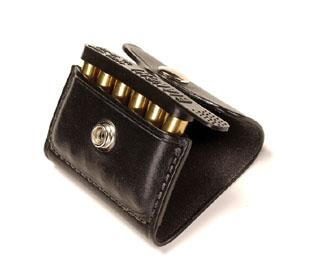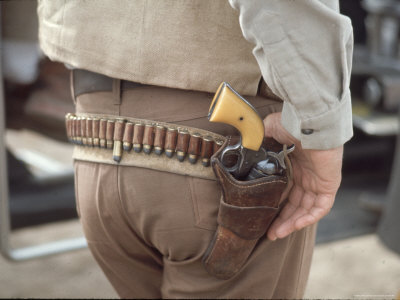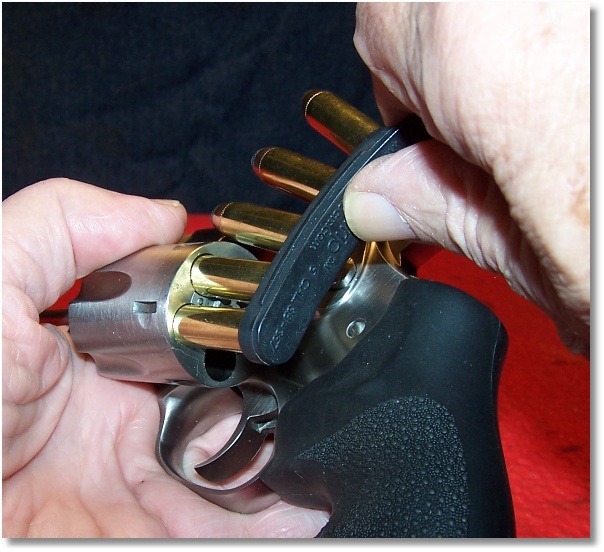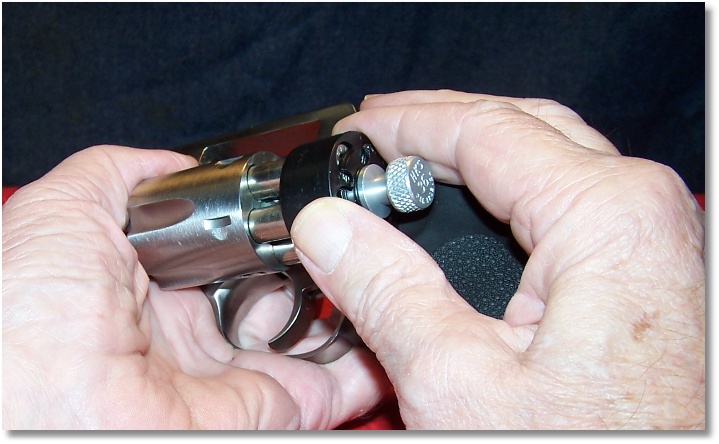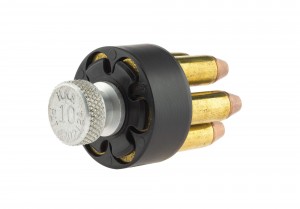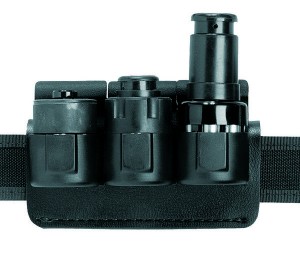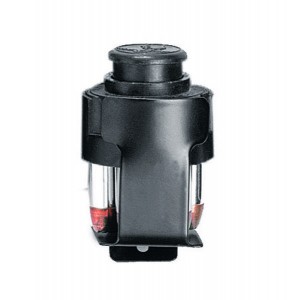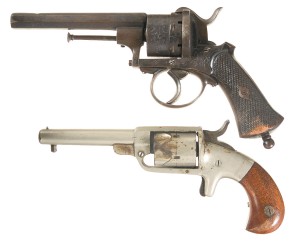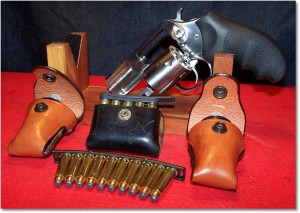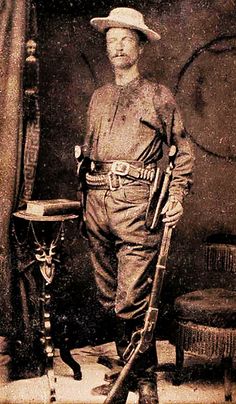 The challenge of carrying spare ammunition for the revolver is not any different today than when revolvers began evolving. Unlike most semi-automatic pistols, revolvers are limited to six or seven rounds of ammunition (.22/.22 WMR revolvers are, of course, an exception). Even double-barreled derringers suffer from the same malady – limited ammunition. Of course, it would be nice to pack as many rounds of extra ammunition as possible, but in most cases that is simply hard to do.
The challenge of carrying spare ammunition for the revolver is not any different today than when revolvers began evolving. Unlike most semi-automatic pistols, revolvers are limited to six or seven rounds of ammunition (.22/.22 WMR revolvers are, of course, an exception). Even double-barreled derringers suffer from the same malady – limited ammunition. Of course, it would be nice to pack as many rounds of extra ammunition as possible, but in most cases that is simply hard to do.
Many packers of pistols say that a minimum of two spare magazines should be carried along with the pistol. Pistols can only hold a limited number in a magazine, but multiple spare magazines full of ammunition provide a convenient way of carrying extra fodder. For some pistols, magazine capacities of 30 rounds are more are available, and even drum magazines can stretch the spare ammunition limit quite a bit. For those of use who carry a revolver for self-defense, whether on occasion or full-time, the challenge of carrying spare ammunition always comes to the forefront at some time or another.
When the percussion cap was introduced, somewhere around 1820 or so, powder and shot was still the main diet for long and hand guns. Powder was still required to fire the ball, but no longer needed to fill a pan because many rifles and handguns were converted to use the new percussion cap. Although revolvers had been around since the 1500s in Europe it wasn’t until Sam Colt patented the revolver in 1836 that widespread use of percussion caps began being used in revolvers. The caplock mechanism consists of a hammer, similar to the hammer used in a flintlock, and a nipple (sometimes referred to as a “cone”), which holds a small percussion cap. The nipple contains a tube which goes into the barrel. The percussion cap contains a chemical compound called mercuric fulminate or fulminate of mercury, whose chemical formula is Hg(ONC)2. It is made from mercury, nitric acid and alcohol. When the trigger releases the hammer, it strikes the cap, causing the mercuric fulminate to explode. The flames from this explosion travel down the tube in the nipple and enter the barrel, where they ignite the main powder charge. Early carry of ammunition dictated that cap and powder be separated.
Paper cartridges were available at the time, but were usually reserved for use in long guns and single-shot pistols. Upon the advent of the revolver; however, a quick means of loading these “sixguns’ was needed. Percussion revolvers, while not truly muzzleloaders, are similar, as they load from the front of the cylinder. Typical paper cartridges for revolvers differ from the robust percussion rifle cartridges, in that the cartridge is inserted into the chamber whole, and rammed into place. Revolver cartridges were often combustible, and the bullet is typically exposed, with the paper cartridge glued, typically with sodium silicate (a high temperature glue that was widely available), as it was also used to preserve fresh eggs. Many examples were tapered, into a cone, being wider at the bullet than at the rear. Some commercially produced cartridges, such as those by Hayes of England, were also equipped with a small cloth tear tab at the front to assist in the removal of the protective outer layer prior to loading the cartridge. When history is looked at, it could be said that Smith & Wesson held up the development of the metallic cartridge due to Rollin White’s patent covering bored through cylinders on a revolver (adopted for a paper cartridge application). This prevented other manufactures from moving forward into the use of metallic cartridge. Metallic cartridges become popular in rim-fire and center-fire configuration. The rim-fire cartridges are still in widespread use today. The center-fire cartridge essentially allowed the percussion cap (what we now call the ‘primer’) to be integrated into a metallic shell’s case and has since ignited gun powder in small and large bore firearms ever since.
When the metallic cartridge became popular, many ‘shot’ bags and pouches were converted to carrying the new cartridges, which usually meant removing a center divider that separated bullet from percussion caps (cones). Belt, waist, and shoulder cartridge bags were common. Sometimes a box or handfuls of cartridges were slipped into a vest or coat pocket. In some cases, where the handgun was not chambered the same as the companion long gun, two separate pockets may contain the ammunition for each weapon. However, all manners of carrying spare ammunition are available to us in today’s time.
CARTRIDGE POUCHES:
Today, the means of carrying spare revolver ammunition range from trouser pockets to competition speed loaders. Back in the day; however, trousers may not have pockets and many a cartridge was carried in some sort of ‘Possibles” bag or a simple pouch. The pouch may be carried over-the-shoulder, around the waist, or hung from a waist belt that also served as a place to secure one or more personal handguns and a good knife.Cartridge pouches can be found that are original or replicas of those carried in early history. “Dump Pouches” provide a convenient way of carrying a reload for a revolver and may hold loose cartridges or cartridges secured by a “Speed Strip” or “Speed Loader” and prevent the primer of a cartridge from coming into contact with other cartridges and possibly “cooking off”, which could spell disaster for the carrier of such rounds.
The Safariland Group, and others, makes some fine cartridges pouches. I use one anytime I pack a revolver and it simply wraps around the belt and is secured by a snap-flap that, when released, provides me with five or six (depending on the model) loose rounds; it will also accommodate a “speed strip” of five rounds for the Ruger SP101 that I carry at times.
Of course, range work and competition calls for different measures than does concealed carry. With that said, if you do use a concealed carry pouch of some sort, its use should be practiced with at the range.
CARTRIDGE BELTS, CARTRIDGE HOLDERS, AND BANDOLEERS:
Since metallic cartridges became available somebody invariably found a way to carry them around the waist or around the body.We see many pictures from the “Old West” of lawmen and desperadoes wearing a bandoleer of both rifle and handgun ammunition. In many cases, the cartridge belts were dedicated to either firearm as many a rifle and revolver were of different chambering.
Cartridge belts were just that – belts for cartridges. Holster were simply slid onto the cartridge belts and adjusted to the wearer’s carry preference (strong-side or cross-draw).
Cartridge belts, obviously, are not conducive to concealed carry but can certainly start up some interesting conversations when they are worn – especially conversations with LEO types while on duty because where there is a cartridge belt, there is a firearm.
Cartridge belts are best reserved for hunting and activities like SASS competition, re-enactments, and range use as the general population while mall shopping might take exception to your wearing a cartridge belt.
I did, at one time, have a good cartridge belt and holster for a Ruger Blackhawk single-action revolver. I actually wore it while primitive camping on one occasion. I have to admit that it was kind of cool being able to wear it and a cross-draw holster that housed a Ruger Blackhawk in .357 magnum chambering. Actually, if felt kind of natural to me; somewhat like I was in another time when…
While cartridge belts are fine for carrying ammunition, ammunition should not be stored in cartridge belts and loops that are made from leather. Over time, the acids used in the tanning process will attack the metal of your cartridges – especially brass.
Cartridge carriers are common and they come in many types from closed-top to open-loop. Both can be slid easily onto a belt, stored in a trouser pocket, and are usually concealed well. For everyday carry purposes, the closed top carrier is better as most are small and highly concealable. Out in the woods, or in competition, carry what you will that works the best for you.
For today’s modern concealed carry person, there are better alternative for carrying spare ammunition; speed strips and speed loaders, and I would like to touch on both.
SPEED STRIPS:
Speed Strips were developed by John Bianchi. Bianchi® Speed Strips™ are a compact loading device for revolvers. Made from a flexible urethane material, these strips securely hold 6 rounds of revolver ammunition and conveniently load two rounds at a time. Speed Strips fit in most single mag/knife pouches and in a trouser or shirt pocket and are offered in two sizes for .38/.357 and .44/.45 caliber rounds.
Speed strips allow you to carry a lot of revolver ammunition securely.
SPEED LOADERS AND CARRIERS
HKS:
Yes sir! I sure could have used an HKS 25-5 during that last gunfight in 1870 with my Smith & Wesson Model 3 in .45 S&W. There I was…HKS speed loaders are very popular among revolver handlers. Individual cartridges are inserted bottom first into a series of chambers and a metal knob is rotated to secure the cartridges. When the speed loader is used to charge a revolvers cylinder, the cartridges are inserted partially into the chambers of the cylinder and the knob is turned to release the cartridges; gravity does the rest as the cartridges fall fully into the individual chambers. The cylinder is closed and the revolver is ready to shoot.
HKS speed loaders are sized for specific calibers and cylinder/chamber sizes.
In order for the speed loader to function properly, sometimes the grip has to be relieved to accommodate the circumference of the speed loader. In most cases, a change of grips or grip panels that allow the use of a speed loader is the easy answer. Hogue manufactures wood and rubber-based grips for most modern revolvers that not only are pleasing to look at but are functional as well.
I have used a carrier for Ruger SP101 speed loaders for several years. A pair of these carriers allows the speed loader to straddle the belt, provides a low profile, and secures the speed loaders as well. Larger speed loaders, such as those for six and seven round cylinders, require the use of a pouch to house the speed loader and are normally attached to the belt in some form or fashion. Speedloader pouches of fabric, Kydex, and leather are widely available for carry and competition. I do not advise the use of pouches (or carriers) intended for competition for defensive and concealed carry purposes. When camping (primitive or otherwise), and when packing a revolver, I normally have a double-nylon speed loader pouch to carry speed loaders to keep them secure and away from the elements of nature.
Safariland:
Safariland offers three variations of speed loader; Comp I, Comp II, and Comp III.The Safariland® Comp I Speedloader is injection molded and its small knob provides maximum concealment for small revolvers, making it most popular for concealment use. Large frame versions offer maximum grip clearance. Depending on the gun, all Safariland® Speedloaders may require custom grips to ensure proper clearance. Offered in two sizes for small J frame and large N frame revolvers. Also fits Colt and Ruger revolvers.
The Safariland® Comp II Speedloader is injection molded and its push-button operation combines maximum speed with easy reloading, making it popular for duty applications. Depending on the gun, all Safariland® Speedloaders may require custom grips to ensure proper clearance. Offered in four sizes for medium (K) and medium large (L) frame revolvers including Colt, Ruger and S&W models.
The Safariland® Comp III Speedloader is injection molded and its spring-driven action provides the fastest, most positive reloading available, making it most popular for competition use. Depending on the gun, all Safariland® Speedloaders may require custom grips to ensure proper clearance. Offered in two sizes: medium (K) and medium large (L) frame.
To load the Safariland Speedloader you insert the cartridges and then push the bullets against a hard surface while twisting the body of the unit to lock the cartridges in place. This is noticeably more difficult than the relatively straightforward loading procedure of the HKS Speedloader.
The advantage of the Safariland design comes when you actually load the revolver. To load, you line up the cartridges with the revolver’s chambers and then press the body of the loader towards the cylinder to unlock the mechanism and release the rounds. This allows you to load the gun without changing your grip on the speedloader to rotate a knob or having to worry about whether or not the cylinder rotates during the reloading process.
I have used the Comp II while on duty and for Police Bullseye competition and I prefer them over the HKS when speed is of a concern.
In my experience, the Safariland Comp II is more resistant to accidentally releasing the rounds than the HKS loaders. While I still recommend using a pouch, if you do have to simply put a speedloader loose in a pocket, the Safariland is the speedloader I’d choose.
Unlike the HKS units, I have experienced problems with worn out Safariland Speedloaders. The symptoms were that the unit would be more difficult to load than normal and would also not always lock securely into place and thus would be more likely to accidentally release the rounds. If this happens, trash the loader and replacing it with a new one.
Speed Loader Choices:
As to which is better for defensive use, they each have their advantages and disadvantages and you have to decide for yourself. The HKS units are easier to load, but are more susceptible to accidentally dumping their rounds. The Safariland loaders are more difficult to load, but many people (as I do) find the pushing motion when loading the revolver quicker and easier than the rotating motion used with the HKS loaders. The Safariland loaders are also more resistant to accidentally unloading the rounds. In fact, unlike the HKS loaders where you can simply rotate the knob to unload the cartridges, you need a pen or similar tool to release the lock to unload the Safariland loaders.
Unfortunately, Safariland Speed Loaders are not available for the Ruger SP101 (I use HKS) but are available for my GP100 and Dan Wesson. I have included a list of other applicable revolvers.
MOON CLIPS AND CARRIERS:
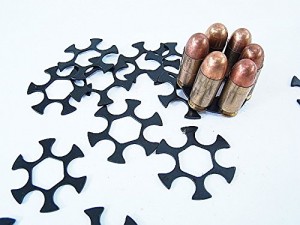
Moon Clips Allow the Loading Of Semi-Automatic Pistol Ammunition Into revolvers Chambered for the Round
A moon clip is a ring-shaped or star-shaped piece of metal designed to hold multiple cartridges together as a unit, for simultaneous insertion and extraction from a revolver cylinder. Moon clips may either hold an entire cylinder’s worth of cartridges together (full moon clip), half a cylinder (half-moon clip), or just two neighboring cartridges. The two-cartridge moon clips can be used for those revolvers that have an odd number of loading chambers such as five or seven and also for those revolvers that allow a shooter to mix both rimless and rimmed types of cartridges in one loading of the same cylinder (for example; 2 adjacent rounds of .45 ACP, 2 rounds of .45 Colt, and 2 rounds of .410 in a single six-chamber S&W Governor cylinder).
The first moon clips came out shortly before World War I. They were designed to allow revolvers to chamber military issue .45 ACP ammo because there was a shortage of 1911 pistols and an abundance of .45 ACP ammunition. Smith & Wesson developed the Model 1917 revolver, which chambered the .45 ACP and used moon clips, for that role.
Moon clips can be used either to chamber rimless cartridges in a double-action revolver (which would normally require rimmed cartridges), or to chamber multiple rimmed cartridges simultaneously. Moon clips are generally made from spring grade steel, although plastic versions have also been produced. Unlike a speedloader, a moon clip remains in place during firing, and after firing, is used to extract the empty cartridge cases – all at once.
Moon clips, like other revolver loading aids can be carried loosely in a pocket or in a loader pouch designed for moon clips or speed loaders.
When loading, you don’t have to fiddle with buttons or knobs—simply drop the rounds in and shut the cylinder.
Moon clips cannot be used in all revolvers; the revolver must be capable of using moon clips and a Smith & Wesson Model 625 revolver is an excellent example. Some police officers carried the Smith & Wesson Model 25 revolver in .45 acp well after semi-automatics became the norm for LEO carry and up to the time law enforcement agencies started adopting the semi-automatic (Beretta and Glock in most cases) as the issued carry.
Carriers for most speedloader are also adequate for carrying ammunition stuffed in moon clips.
BACK-UP FIREARM:
An alternate means of carrying spare ammunition is to carry them in another revolver; albeit a smaller version of the primary revolver.There was a time when the carrying of two, three, or even four revolvers was a necessity in providing for the safety and welfare of those who carried them. Good and bad men alike might carry a brace of Colt revolvers or have a single-revolver and a “hide-out’ carried elsewhere on the body. Contrary to popular belief, the “New York” reload did not originate in New York, but had originated generations earlier, and just because revolvers were the new craze in town, folks just didn’t drop back to just one revolver, as front-loading percussion revolvers then meant loading multiple chambers rather than a single bore and that was a time consuming process – especially in battle.
Today, with all of the lightweight revolvers available to us, I would imagine that someone is still bent on carrying two (or more) firearms (revolver or pistol) for any number of reasons.
WRAP UP:
The revolver is still carried by a number of folks who desire them for personal defense. Carrying additional ammunition is essential regardless of the firearm being carried. Fortunately, there are many means to accommodate carrying additional ammunition for the revolver and consideration of each is left up to the user as to his or her particular needs.When I do pack a six-shooter, I normally carry both speed loaders and speed strips with the former being much faster to operate than the latter. Both of which do not weight me down as much as the Ruger SP101 that is normally carried. When I am camping (which is becoming more rare), and when I don’t sport a single-action revolver, a Ruger GP141 in .357 magnum accompanies me and is supported by two Safariland speed loaders and several speed strips.
As I do not leave home without two spare magazines for the current semiautomatic pistol carry, I would be remiss in my responsibility for my own safety and welfare in not carrying an adequate supply of spare ammunition for a revolver when toted. Speed Strips, Speed Loaders, and appropriate carriers for both are a necessity for carrying spare revolver ammunition in these days and times, which are really not too different from times past when you stop and think about it. In fact, there was this time in 1870 when I…
![]()



